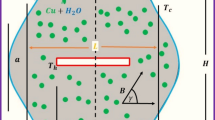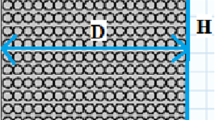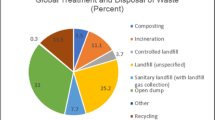Abstract
To control the landfill gas (LFG) emission, LFG collection systems with vertical wells are extensively used in municipal solid waste (MSW) landfills. When investigating the LFG flow behavior, the solid–liquid–gas interactions cannot be neglected, especially in bioreactor landfills. In this study, an axisymmetric numerical model incorporating MSW compression and leachate recirculation was developed to describe the transient gas flow in bioreactor landfills. In the model, the porosity distribution was evaluated through circular computations, and the temporal and spatial changes in moisture were determined using the unsaturated–saturated seepage flow model. Based on these calculations, the governing equations of gas migration were solved using the finite element method. The influences of MSW properties, recirculation rate and well vacuum pressure were then investigated. The results show that the MSW compression and leachate recirculation have a significant impact on the distributions of gas generation, permeability and pressure. As the recirculation rate increases from 1 to 9 mm day−1, the gas permeability can decrease about 1 order of magnitude and thus the radius of influence decreases from 39 to 31 m. It is important to keep a balance between the acceleration of landfill stability and the recovery efficiency of LFG. These results provide helpful guidelines for the design of leachate recirculation and LFG control systems.













Similar content being viewed by others
Abbreviations
- f g,t :
-
Gas generation rate (M L−3 T−1)
- f water :
-
Water content factor
- m s0 :
-
Initial mass of solid matter (M)
- V s, V v :
-
Volumes of solid phase and void space at time t, respectively (L3)
- V s0, V v0 :
-
Initial volumes of solid phase and void space, respectively (L3)
- A i :
-
Proportion of biodegradable component i
- c i :
-
Decomposition rate constant of biodegradable component i (T−1)
- n, ε :
-
Porosity and compression strain, respectively
- w 0 :
-
Initial gravimetric moisture content
- n 0 :
-
Initial total porosity of MSW
- ρ d0 :
-
Initial dry density of MSW (M L−3)
- ρ d :
-
Dry density of MSW (M L−3)
- ρ s, ρ l, ρ g :
-
Solid, liquid and gas density, respectively (M L−3)
- γ 0 :
-
Initial unit weight of MSW (M L−2 T−2)
- σ cover :
-
Self-weight stress of final cover (M L−1 T−2)
- σ′, σ c :
-
Effective and preconsolidation stress, respectively (M L−1 T−2)
- g :
-
Gravitational acceleration (L T−2)
- μ s, C(h):
-
Storativity and water capacity (L−1)
- m v :
-
Coefficient of MSW volume change (M−1 L T2)
- β :
-
Water compression coefficient (M−1 L T2)
- μ g, μ l :
-
Dynamic viscosity for gas and liquid, respectively (M L−1 T−1)
- k i, K c :
-
Intrinsic permeability of MSW and landfill cover, respectively (L2)
- k rg, k rl :
-
Relative permeability for gas and liquid, respectively
- k :
-
Anisotropic coefficient
- t′, t :
-
Time elapsed since waste deposition and landfill closure, respectively (T)
- t f :
-
Total time required to fill the landfill (T)
- v gz , v gr :
-
Vertical and radial velocities of the gas phase, respectively (L T−1)
- P g :
-
Absolute gas pressure (M L−1 T−2)
- P atm :
-
Atmospheric pressure (M L−1 T−2)
- P w, p w :
-
Absolute and relative pressure at well boundary, respectively (M L−1 T−2)
- R g :
-
Gas constant (L2 T−2 K−1)
- T :
-
Absolute temperature (K)
- S g, S l :
-
Gas and liquid saturation, respectively
- S min :
-
Minimum liquid saturation needed for biodegradation
- S e :
-
Effective liquid saturation
- S l0, S lr, S lm :
-
Initial, residual and maximum liquid saturation, respectively
- H, H c :
-
Thickness of landfill and cover, respectively (L)
- H 0, ∆H :
-
Initial thickness and settlement of a waste layer (L)
- z, r :
-
Height and radius, respectively (L)
- r w, R :
-
Well radius and half well distance, respectively (L)
- r ae :
-
Radial coordinate where gas vertical flux at the top is equal to zero (L)
- h :
-
Head pressure (L)
- Q b :
-
Influx of gas from the landfill base (M L−2 T−1)
- f gz :
-
Vertical gas flux (M L−2 T−1)
- Q prod, Q out :
-
Amount of total generated gas and gas emission, respectively (M T−1)
- Q l :
-
Leachate recirculation rate (L T−1)
- m, n v , α :
-
Coefficients in the van-Genuchten relationship
- C r :
-
Experimentally measured settlement coefficient
- ω, ξ :
-
Coefficients (ω = 1, ξ = 0 for h ≥ 0; ω = 0, ξ = 1 for h < 0)
- C 1 :
-
Constant for an empirical formula (L2)
- C 2 :
-
Constant for an empirical formula
References
Arigala SG, Tsotsis TT, Webster IA, Yortsos YC, Kattapuram JJ (1995) Gas generation, transport, and extraction in landfills. J Environ Eng ASCE 121(1):33–44
Chen YM, Xie Y, Zhan LT (2006) One-dimensional consolidation model for landfills considering solid-liquid-gas interaction. Chin J Geotech Eng 28(2):184–190 (in Chinese)
Chen YM, Zhan LT, Wei HY, Ke H (2009) Aging and compressibility of municipal solid wastes. Waste Manag 29(1):86–95
Chen YM, Xu XB, Zhan LT (2012) Analysis of solid-liquid-gas interactions in landfilled municipal solid waste by a bio-hydro-mechanical coupled model. Sci China Technol Sci 55(1):81–89
Danhamer H, Jager J (1998) Gasbildung mechanisch-biologisch Vorbehandelter Abfälle; Einfluss der Temperatur und des Wassergehalts (Gas formation in mechanical-biological treated waste; influence of temperature and water content), BMBF-Statusseminar des Verbundvorhabens Mechanisch-biologische Behandlung von zu deponierenden Abfällen, 17.3–19.3.1998, Universität Potsdam, Germany
Durmusoglu E (2002) Municipal landfill settlement with refuse decomposition and gas generation. Ph.D. Thesis, Texas A&M University, USA
Durmusoglu E, Corapcioglu MY, Tuncay K (2005) Landfill settlement with decomposition and gas generation. J Environ Eng 131(9):1311–1321
Durmusoglu E, Sanchez IM, Corapcioglu MY (2006) Permeability and compression characteristics of municipal solid waste samples. Environ Geol 50:773–786
Faour AA, Reinhart DR, You H (2007) First-order kinetic gas generation model parameters for wet landfills. Waste Manag 27(7):946–953
Feng SJ, Zhang X (2013) Unsaturated-saturated seepage analysis for leachate recirculation using horizontal trenches in bioreactor landfills. Chin J Geotech Eng 7:1355–1361 (in Chinese)
García De Cortázar AL, Tejero Monzón I (2007) Application of simulation models to the diagnosis of MSW landfills: an example. Waste Manag 27(5):691–703
Hettiarachchi H, Meegoda J, Hettiaratchi P (2009) Effects of gas and moisture on modeling of bioreactor landfill settlement. Waste Manag 29(3):1018–1025
Huang Q, Wang Q, Dong L, Xi BD, Zhou BY (2006) The current situation of solid waste management in China. J Mater Cycles Waste Manag 8(1):63–69
Jain P, Powell J, Townsend TG, Reinhart DR (2005) Air permeability of waste in a municipal solid waste landfill. J Environ Eng 131(11):1565–1573
Jain P, Townsend TG, Tolaymat TM (2014) Transient design of landfill liquid addition systems. Waste Manag 34:1667–1673
Li YC, Cleall PJ, Ma XF, Zhan LT, Chen YM (2012) Gas pressure model for layered municipal solid waste landfills. J Environ Eng 138(7):752–760
McDougall J (2007) A hydro-bio-mechanical model for settlement and other behaviour in landfilled waste. Comput Geotech 34(4):229–246
Meima JA, Naranjo NM, Haarstrick A (2008) Sensitivity analysis and literature review of parameters controlling local biodegradation processes in municipal solid waste landfills. Waste Manag 28(5):904–918
Reddy KR, Hettiarachchi H, Parakalla NS, Gangathulasi J, Bogner JE (2009) Geotechnical properties of fresh municipal solid waste at Orchard Hills Landfill, USA. Waste Manag 29(2):952–959
Reddy KR, Hettiarachchi H, Gangathulasi J, Bogner JE (2011) Geotechnical properties of municipal solid waste at different phases of biodegradation. Waste Manag 31(11):2275–2286
Sharma HD, Reddy KR (2004) Geoenvironmental engineering: site remediation, waste containment and emerging waste management technologies. Wiley, New Jersey
Stoltz G (2009) Transferts en milieu poreux biodégradable, non saturé, déformable et à double porosité: application aux ISDND. Ph.D. Thesis, Université Joseph-Fourier, Grenoble, France
Stoltz G, Gourc J, Oxarango L (2010a) Characterisation of the physico-mechanical parameters of MSW. Waste Manag 30(8–9):1439–1449
Stoltz G, Gourc J, Oxarango L (2010b) Liquid and gas permeabilities of unsaturated municipal solid waste under compression. J Contam Hydrol 118(1–2):27–42
Tchobanoglous G, Theisen H, Vigil SA (1993) Integrated solid waste management. McGraw-Hill Inc, NY
Tinet AJ, Oxarango L (2010) Stationary gas flow to a vertical extraction well in MSW landfill considering the effect of mechanical settlement on hydraulic properties. Chem Eng Sci 65(23):6229–6237
Townsend TG, Wise WR, Jain P (2005) One-dimensional gas flow model for horizontal gas collection systems at municipal solid waste landfills. J Environ Eng 131(12):1716–1723
Van Genuchten MT (1980) A closed-form equation for predicting the hydraulic conductivity of unsaturated soils. Soil Sci Soc Am J 44(5):892–898
Vigneault H, Lefebvre R, Nastev M (2004) Numerical simulation of the radius of influence for landfill gas wells. Vadose Zone Journal 3(3):909–916
Wei HY (2007) Experimental and numerical study on gas migration in landfill of municipal solid waste. Ph.D. Thesis, Zhejian University, Hangzhou, China (in Chinese)
White J, Robinson J, Ren Q (2004) Modelling the biochemical degradation of solid waste in landfills. Waste Manag 24(3):227–240
White JK, Beaven RP, Powrie W (2011) Leachate recirculation in a landfill: some insights obtained from the development of a simple 1-D model. Waste Manag 31(6):1210–1221
Wise WR, Townsend TG (2011) One-dimensional gas flow models for municipal solid waste landfills: cylindrical and spherical symmetries. J Environ Eng 137(6):514–516
Yu L, Batlle F, Carrera J, Lloret A (2009) Gas flow to a vertical gas extraction well in deformable MSW landfills. J Hazard Mater 168(2–3):1404–1416
Acknowledgments
Much of the work described in this paper was supported by the National Natural Science Foundation of China under Grant Nos. 41172245 and 41222021, the National Basic Research Program of China (973 Program) under Grant No. 2012CB719803 and the Program for New Century Excellent Talents in University under Grant No. NCET-13-0421. The writers would like to greatly acknowledge all these financial supports and express the most sincere gratitude.
Author information
Authors and Affiliations
Corresponding author
Rights and permissions
About this article
Cite this article
Feng, SJ., Zheng, QT. & Xie, HJ. Axisymmetric gas flow model for bioreactor landfills incorporating MSW compression and leachate recirculation. Environ Earth Sci 75, 23 (2016). https://doi.org/10.1007/s12665-015-4827-3
Received:
Accepted:
Published:
DOI: https://doi.org/10.1007/s12665-015-4827-3




